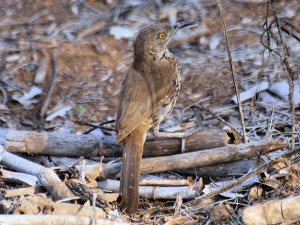Gray Thrasher is a non-migratory endemic to Baja California, so when Sunday afternoon on August 2, 2015 was interrupted with a report of the first US occurrence in San Diego, we had to make the 75 mile drive and take a look.
Finding the Gray Thrasher
The Gray Thrasher was found by John Bruin, Lisa Ruby, and Terry Hurst at the southwest end of Famosa Slough. This area has had its share of rarities, including Bar-tailed Godwit. Once we arrived and parked, we quickly found a couple of dozen birders standing around. Others were searching for the bird in other parts of the area. We learned where it had been seen (about 45 minutes before our arrival) and which way it went. Since it obviously wasn’t where everyone was standing, we decided to look around. Just after our fourth pass by a large lemonade berry bush, someone spotted the Gray Thrasher deep in the foliage. Birders surrounded the bush looking for a better angle. All of a sudden, the thrasher decided it was hungry and came out onto the slope to forage in the leaves and twigs only about 15 feet away from us. That was too close for my Kowa TSN-884, but just right for binoculars.
Identification
Gray Thrasher is similar in size to Curve-billed Thrasher, and in coloration to Long-billed Thrasher. They have golden-yellow eyes and a white breast covered with discrete dark brown to black chevron-shaped spots. These are much more prominent than the dull, smudgy spots of Curve-billed Thrasher or the long, continuous streaks of Long-billed Thrasher. Other field marks include a buff wash to the flanks and brighter cinnamon-brown on the rump and upper tail coverts (evident in the dorsal view photo to the right).
Acceptance
The identification of the Gray Thrasher was not in doubt. Birders, especially those on the California Bird Records Committee (CBRC), may long debate whether this bird arrived naturally or was an escaped cage bird. There are plenty of arguments on both sides of the discussion. Not only does Gray Thrasher not migrate, it barely moves around within its range. This individual was of the subspecies mearnsi. Its range gets within about 120 miles from Famosa Slough. So, if it decided to go exploring, it was well within reach.
Experts have been active on the local birding discussion lists, giving their opinions. They compare how other non-migratory species that have shown up in the US southwest might compare to the Gray Thrasher making it here. Needless to say, opinions are split, or at least equivocal. The preferred habitat for Gray Thrasher is desert with candelabra cactus. This is quite unlike Famosa Slough, which may be why the bird was not refound the following day. Of course, nobody knows for sure what brought the Gray Thrasher to San Diego, so it will be interesting to see what the CBRC decides.



